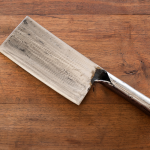Mozuko
Seaweed, a bit of vinegar, and a raw quail egg
Sunomono
Scallop, crab, octopus, cucumber, a bit of vinegar, and sesame seeds for decoration
Appetizer; normally offered by the itamae
Kobe gyutataki
Kobe beef, the most delicate of all beefs in the world, lightly seared and nice and red in the center of each morsel
Expensive and usually available in the autumn or winter
Shishamo
Grilled capellin
Eat it whole, starting with the head; normally full of delicious caviar; summer fish of the north Pacific and Atlantic, related to the smelt
Tekka donburi
Slices of red tuna served atop a bowl of sushi rice
A snack common at tekka gambling places
Sawagani
Fried river crab
Itamaes keep them alive at the restaurant and cook them on-demand when you order; eat them alone on a bed of seaweed salad or atop a spider roll
Oshinko
Burdock, radish, and other pickled roots
Various roots, pickled, in addition to gari (ginger).
Nakaochi donburi
Tuna scrapings served atop a bowl of sushi rice
Similar to tekka donburi but much, much tastier. The itamae scrapes the tuna flesh off the regions next to the fish’s spine. This tuna is very tasty and very, very tender. Dip each morsel in soy sauce.
Vegetarian Sushi
Vegetables have always been an important component of sushi, and many traditional varieties are mostly or completely vegetarian. There is no excuse for vegetarians or vegans to not join you at the sushi bar. From kappa maki (cucumber roll) to sophisticated nigiri ensembles, itamaes always figure out a way of creating some interesting and delicious vegetarian sushi. If you’re a vegan, join your fish-eating friends and just let the itamae know about what you like. Most itamaes will go out of their way to create custom vegetarian sushi to suit your taste and needs.
Becoming a Master : Beyond Nigiri and Makisushi
There is one more level to the sushi experience. This is where you find the most exotic sushi, the one that separates you from the rest. You can really tell others that you know how to eat sushi after you’ve experienced the delicacies in this section. Beware that most of these are also on the pricey column of the menu.
- Uni: sea urchin caviar (roe). It’s considered one of the most delicate pleasures at the sushi bar. Uni is a dark yellow mass served on nigiri, with a strong nutty flavor coming from the iodine found in the sea urchin. Always eat it fresh; the grossest thing you can eat is old or previously frozen uni.
- Fugu: Poisonous Japanese blowfish. It’s the most delicate and sensual of all sushi plates. Your lips and tongue literally tingle while you eat it–and for at least a half hour afterward. The fugu experience is like a long-lasting sensuous kiss.
- Hebo: Bee larvae. Roasted in honey, hebo will be served in a very small porcelain container. Pick one or two at a time, eating them in between other types of sushi. Their flavor explodes in your mouth, blending the hebo with the honey and flowers flavor.
- Amaebi: Fresh water shrimp. Raw fresh water shrimp nigiri. The head (and sometimes the shell) of the shrimp are fried and served separately. Squeeze some lemon juice on them and eat them.
- Odori: Dancing langoustine. Raw live baby langoustines. There is nothing quite like watching your food move its antennas as you eat it.
- Inago: Roasted grasshoppers. Served as nigiri. The taste like shrimp with a bit of lemon.
- Kazunoko: Herring caviar. Consummed as a traditional New Year’s sushi. Also known as “yellow diamonds” because of its texture and exorbitant price in Japan. If you live anywhere from the Bay Area to Mexico City, however, kazunoko is very reasonably priced: The best kazunoko comes from the waters around San Francisco.
- Idtakko: Baby octopus. Served atop nigiri, with each octopus (head and tentacles) fitting comfortably on top of the rice.
- Ankimo: Monkfish liver. Think foie gras and you’ll get the idea.
- Hamachi kama: Yellowtail shoulder. This consists of the area right behind the fish’s head, served grilled on a plate along with some shredded daikon radish and a bit of garlic. Squeeze a few lemon drops over the fish, then carefully separate the meat from the skin and the single bone. Pour some soy sauce (not too much) over the daikon. Garnish each bite of fish with daikon. You will enjoy the most delicate grilled fish you’ve ever eaten.
- Tai kabutoyaki: Red napper grilled head, a delicacy from Western Japan. Exactly what its name describes: a grilled red snapper head, served on a plate along with some shredded daikon and lemon. Kabuto is the archaic Japanese word for the helmet that the samurai wore. See the hamachi kama preparation. Eat all the meat around the head, and pay special attention to the eye: it’s delicious! To eat the eye: remove the round white thing. Dig the eye out of the socket; it’ll have the consistency of jelly. Add a couple of drops of lemon juice and pop it in your mouth… amazing!
- Matsutake tobimushi: Mushroom and seafood soup served in a teapot. The soup is prepared inside the teapot. It contains mushrooms, shrimp, fish cake, a ginko nut, and plenty of kaiware. The broth is very delicate to the palate. Open the teapot, add some sudachi (lime) juice, and stir lightly with your chopsticks. Let it rest for a minute or so, then pour the broth in the accompanying cup. Fetch some of the goodies from inside the pot at regular intervals. Be careful… this soup is very hot! You may see detailed photos featuring these instructions in the Sushi Eating HOWTO Companion.






